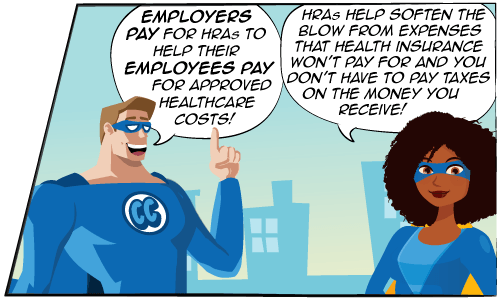
"HRAs may seem complicated, but they’re actually easier to understand than you think. Check out this HRA video with me and Captain Contributor. You’ll get great information about the HRA, ICHRA, EBHRA and QSEHRA."
What’s more? Watch this HRA video to solve these puzzling riddles:
- Will we be overtaken by robot overlords?
- Why is busting through walls so much fun?
- Is the supervillain using the latest robot technology?
- Are vacations an eligible healthcare expense?
HRA Information
A Health Reimbursement Arrangement (HRA) is an employer-sponsored benefit account that allows employees to pay for out-of-pocket healthcare expenses. An HRA is owned and funded by the employer.
One of the biggest benefits of an HRA is that the amount of money that goes into your HRA does not count as income. Plus, you do not have to pay taxes on it.
HRA Types
There are four types of HRAs:
- Standard HRA
- Individual Coverage HRA (ICHRA)
- Excepted Benefit HRA (EBHRA)
- Qualified Small Employer HRA (QSEHRA)
HRA Expenses
An HRA can pay for a variety of IRS-approved healthcare expenses. However, the employer may pick and choose what to cover, and each employer is different. HRAs are commonly used for:
- Copays
- Deductibles
- Prescription medications
- Dental care
- Eye care

HRA Benefits Card
Depending on your plan, you may be able to get an HRA benefits card. This will help you pay for those out-of-pocket expenses without having to file a claim for reimbursement.
HRA Rules
Each plan has a Summary Plan Description (SPD). In the SPD, you will find out vital information, including:
- How much benefit dollars you’ll receive
- What your account will cover
- Who your account will cover
- Does unspent money roll over, or will you lose it
